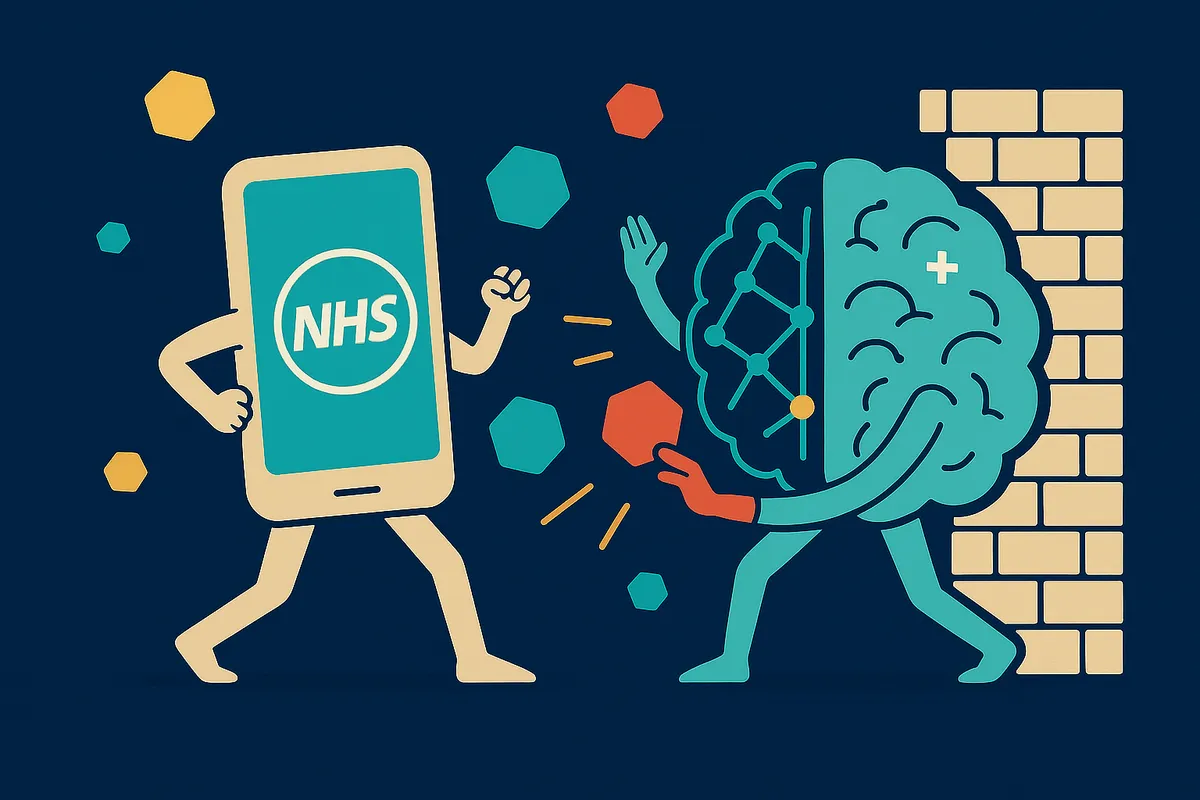(Why the “digital front door” strategy needs a rethink in an AI-first world)
The latest PAGB Self-Care Census shows a stark reality the NHS can’t ignore: every year, at least 25 million GP appointments and 5 million A&E visits are for self-treatable conditions; mostly because patients lack confidence to self-care, even though 78% say they’d prefer to manage their health themselves (PAGB).
The Government’s response? Transform the NHS App into the “digital front door” for care, as set out in its 10-Year Health Plan. On the surface, it makes sense: one trusted hub for booking, advice and self-care support. The ambition even ties to a bigger goal - reducing health inequalities by breaking down barriers to access.
It sounds right in principle. But the strategy? That’s where things need to change.
The ambition is right. The execution isn’t.
Turning the NHS App into a single digital destination assumes patients will start their journey there. Behavioural reality says otherwise. Most patients don’t think “I’ll open an app.” They think “I’ll Google it.” And increasingly, they don’t even do that - they ask ChatGPT, Perplexity or Claude for the answer.
That behaviour shift isn’t hypothetical. As we argued in Patients don’t search anymore. They ask AI - are you ready?, health queries are already migrating to AI platforms because they deliver what people want: fast, simple answers without endless link-hopping.
Trying to force a download-first approach in that reality feels like designing for a world that no longer exists. Behaviour doesn’t change because policy says so. It changes because the easiest option gets even easier. And right now, the easiest option lives inside Big Tech ecosystems, not in standalone health apps.
Why walled gardens fail
AI is not just another channel. It’s collapsing the traditional user journey. No browsing, no clicking, no scrolling. Patients ask a question and get an answer in seconds.
If NHS strategy remains centred on its own app, two risks emerge:
-
Patients never reach NHS content because AI serves up something else first.
-
Misinformation fills the gap, with consequences for health outcomes and system costs.
And here’s the irony: the NHS’s aim is to reduce health inequalities. But if accurate advice only lives inside an app, access becomes harder, not easier. The people least likely to download the NHS App are often those most in need. True equity means meeting people on the platforms they already use and ensuring the first answer they see is clinically accurate.
A better model: integrate, don’t isolate
Instead of trying to out-Google the Googlers, the NHS should rethink what “digital front door” really means. It isn’t a single app. It’s every entry point where patients start their health journey.
Imagine this:
A patient asks Siri or Alexa about a child’s fever. The response starts with:
“According to the NHS…”.
That is how trust is built at scale.
From there, the experience can deepen. The user books a GP appointment through an embedded pathway or checks local pharmacy availability without leaving the interface they’re already in. This isn’t fantasy. It’s how consumer ecosystems already work in sectors from finance to retail.
Yes, there are data concerns. But anonymised and federated AI models, show it’s possible to train systems without compromising patient privacy. Done well, this doesn’t just solve access, it enables preventative care by identifying risk patterns earlier and easing the load on over-stretched GPs through smarter AI-driven triage.
Other nations prove the model works
This isn’t theory. It’s happening.
-
Singapore’s Synapxe HealthHub is embedding AI assistants into its national portal, offering personalised health guidance and soon, appointment booking —> meeting patients inside familiar channels.
-
The Netherlands’ Luscii enables virtual wards by embedding AI into provider systems —> improving care without forcing behaviour change, claiming to cut hospital admissions by over 80%.
Neither is perfect, but both point to the same truth: integration beats isolation.
What could the NHS do next?
We know it’s easy to critique from the outside. So here are five ideas - some practical, some blue-sky - that could make the “digital front door” strategy fit for an AI-first world:
-
Partner with platform owners - Negotiate agreements with Google, Amazon, and OpenAI to embed NHS-verified advice in AI responses and voice assistants.
-
Open APIs for care pathways - Enable secure booking and triage services that plug into third-party interfaces like search, smart speakers, and chatbots.
-
Create NHS-approved AI answer standards - Develop a certification framework for health answers, so AI platforms can confidently source authoritative information.
-
Pilot federated data learning - Explore models that allow AI to learn from anonymised patient data without compromising privacy - unlocking population health insights.
-
Invest in trust signals for AI ecosystems - Ensure NHS branding appears prominently in AI summaries, so patients know their guidance comes from a trusted source.
These aren’t quick fixes, and they’re not without complexity. But they point to a future where the NHS meets patients where they already are, rather than pulling them into yet another closed system.
Time to rethink what ‘digital front door’ means
If success is measured by app installs or referral numbers, we’ve already missed the point.
Real success means patients adopting self-care confidently and appropriately, with everyone accessing the same clinically accurate information regardless of platform, reducing unnecessary GP and A&E visits, and ultimately improving population health outcomes.
The NHS’s ambition to empower self-care is right. But if strategy doesn’t adapt to behaviour and technology, it risks building a digital cul-de-sac.
The “front door” isn’t an app. It’s the first place patients go for answers - and right now, that’s not inside NHS walls. It’s inside platforms run by Big Tech.
The question is whether the NHS will compete - or collaborate. Because the future of self-care will not live in a single app. It will live everywhere patients ask their first question.
